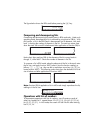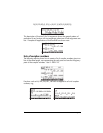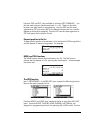
Page 8-7
%({10,20,30},{1,2,3}) = {%(10,1),%(20,2),%(30,3)}
This description of function % for list arguments shows the general pattern of
evaluation of any function with two arguments when one or both arguments are
lists. Examples of applications of function RND are shown next:
Lists of complex numbers
The following exercise shows how to create a list of complex numbers given two
lists of the same length, one representing the real parts and one the imaginary
parts of the complex numbers. Use L1 ADD i*L2.
Functions such as LN, EXP, SQ, etc., can also be applied to a list of complex
numbers, e.g.,


















